
Drosera, which is commonly known as the sundews, is one of the largest genera of carnivorous plants, with at least 194 species. These members of the family Droseraceae lure, capture, and digest insects using stalked mucilaginous glands covering their leaf surfaces. The insects are used to supplement the poor mineral nutrition of the soil in which the plants grow. Various species, which vary greatly in size and form, are native to every continent except Antarctica.

Lysimachia is a genus consisting of 193 accepted species of flowering plants traditionally classified in the family Primulaceae. Based on a molecular phylogenetic study it was transferred to the family Myrsinaceae, before this family was later merged into the Primulaceae.

Drosera rotundifolia, the round-leaved sundew, roundleaf sundew, or common sundew, is a carnivorous species of flowering plant that grows in bogs, marshes and fens. One of the most widespread sundew species, it has a circumboreal distribution, being found in all of northern Europe, much of Siberia, large parts of northern North America, Korea and Japan but is also found as far south as California, Mississippi and Alabama in the United States of America and in New Guinea.
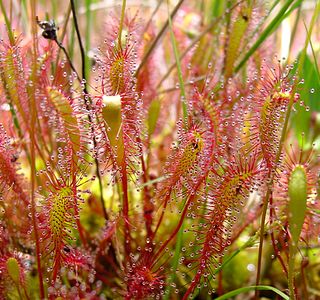
Drosera anglica, commonly known as the English sundew or great sundew, is a carnivorous flowering plant species belonging to the sundew family Droseraceae. It is a temperate species with a circumboreal range, although it does occur as far south as Japan, southern Europe, and the island of Kauai in Hawaii, where it grows as a tropical sundew. It is thought to originate from an amphidiploid hybrid of D. rotundifolia and D. linearis, meaning that a sterile hybrid between these two species doubled its chromosomes to produce fertile progeny which stabilized into the current D. anglica.
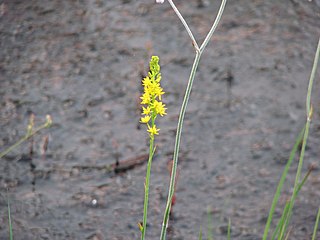
Narthecium americanum is a species of flowering plant in the Nartheciaceae known by the common names yellow asphodel and bog asphodel. It is native to New Jersey in the United States. It is now apparently limited to that state, having likely been extirpated from Delaware, North Carolina, and South Carolina.

Pocosin is a type of palustrine wetland with deep, acidic, sandy, peat soils. Groundwater saturates the soil except during brief seasonal dry spells and during prolonged droughts. Pocosin soils are nutrient-deficient (oligotrophic), especially in phosphorus.

Drosera intermedia, commonly known as the oblong-leaved sundew, spoonleaf sundew, or spatulate leaved sundew, is an insectivorous plant species belonging to the sundew genus. It is a temperate or tropical species native to Europe, southeastern Canada, the eastern half of the United States, Cuba, Hispaniola, and northern South America.
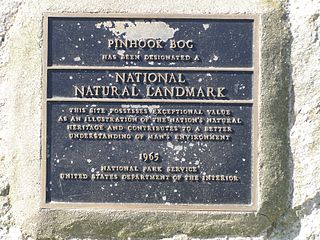
Pinhook Bog is a unique bog in Indiana that has been designated a National Natural Landmark. It is part of Indiana Dunes National Park, an area that many citizens, scientists, and politicians fought hard to preserve. Its sister bog, Volo Bog, is located nearby. The bog contains a large variety of plants, including insect eating plants, tamarack trees, stands of blueberry bushes, and floating mats of sphagnum moss. Pinhook Bog is about 580 acres (2.3 km2), a quarter of which is a floating mat of sphagnum peat moss. A "moat" separates the bog from the uplands.

Lysimachia thyrsiflora, the tufted loosestrife, is a plant in the genus Lysimachia. It is native to large sections of the northern Northern Hemisphere, including Eurasia and North America. It often grows in marshes, shorelines of lakes and ponds and occasionally along streams. It is an erect perennial herb growing up to 80 centimeters tall and bearing yellow flowers, sometimes dotted with purple. It may be confused with purple loosestrife when not blooming but can be easily distinguished because purple loosestrife has a square stem. Tufted loosestrife has been used medicinally in Asia to combat high blood pressure.
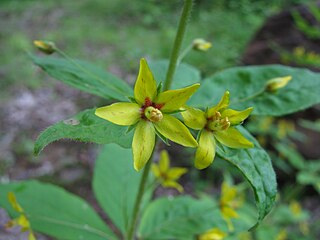
Lysimachia quadrifolia, the whorled loosestrife, whorled yellow loosestrife, or crosswort, is a species of herbaceous plant in the family Primulaceae. It native to the eastern United States and Canada.

Warea carteri is a species of plant in the mustard family, Brassicaceae, known by the common names Carter's pinelandcress and Carter's mustard. It is an endangered, fire-dependent annual herb occurring in xeric, shrub-dominated habitats on the Lake Wales Ridge of central Florida in the United States.
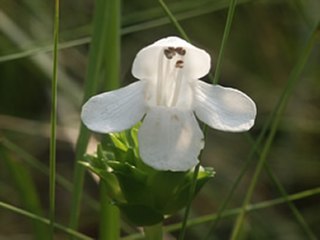
Macbridea alba is a rare species of flowering plant in the mint family known by the common name white birds-in-a-nest. It is endemic to Florida in the United States, where it is found in four counties in the Florida Panhandle. It is threatened by the loss and degradation of its habitat, and it is federally listed as a threatened species of the United States.

Rhynchospora knieskernii is a rare species of sedge known by the common name Knieskern's beaksedge. It is endemic to the state of New Jersey in the United States, where it occurs naturallyin the Pine Barrens. Reports have cited it present in Delaware as well, but these populations appear to have been introduced. It is threatened by the destruction and degradation of its habitat. It is a federally listed threatened species of the United States.
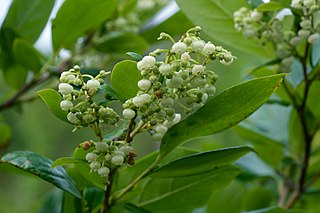
Lyonia ligustrina is a species of flowering plant in the family Ericaceae known by the common names maleberry and he-huckleberry. It is native to the eastern United States from Maine to Florida and west to Texas and Oklahoma.
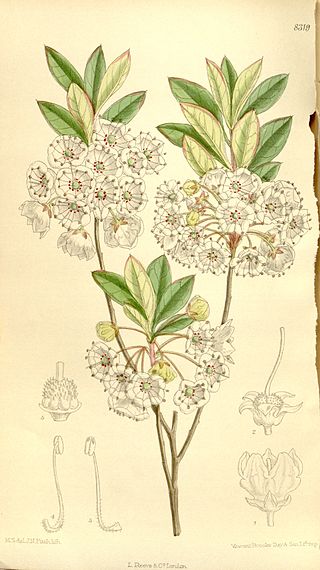
Kalmia cuneata is a species of flowering plant in the heath family known by the common name whitewicky, sometimes spelled white-wicky or white wicky. It is native to the eastern United States, where it occurs only in North Carolina and South Carolina.

Parnassia caroliniana is a species of flowering plant in the Celastraceae known by the common name Carolina grass of Parnassus. It is native to the southeastern United States, where it occurs in North Carolina and South Carolina, with an isolated population in the Florida Panhandle.
Solidago verna is a species of flowering plant in the aster family known by the common names springflowering goldenrod and spring goldenrod. It is native to North Carolina and South Carolina in the United States.

Kingsley Common is a 41-hectare (100-acre) protected area in Kingsley, Hampshire, England. The site holds many rare species of animals and birds. Some species of plants and animals may also be subject to special protection under Part I of the Wildlife and Countryside Act 1981, or under the Habitats Regulations 1994.

Grīņu Nature Reserve is a nature reserve, located in Saka Parish, South Kurzeme Municipality in the Courland region of Latvia. Founded in 1936, it belongs to the European Conservation Network Natura 2000. 1,505 hectares of natural habitat are under protection. The Grīņu Reserve is subordinated to the Regional Council for Nature Conservation Courland.



















